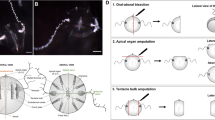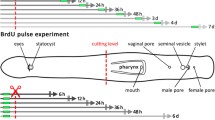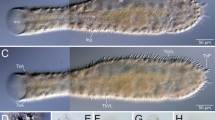Summary
Both anterior wounds (first eight segments removed) and shallow body wall wounds in Eisenia foetida are definitively closed by migration of epidermal columnar cells which undergo few morphological changes in the process. Epidermal basal cells do not contribute directly to wound epithelialization, but they enter the plug of cells which acts as the substratum for the columnar cells and function mainly as phagocytes. Epidermal gland cells, which also do not contribute to wound covering, degenerate and are phagocytized at the wound margins. The gland cells which re-form in the new wound epithelium probably arise from columnar cells. There is no change in the epidermal basement lamella during healing, but epidermal cuticle synthesis is stimulated. In the outer region of the forming cuticle the fiber bundles become disorganized and in the inner region fine filaments and larger, faintly striated fibers are laid down. The number of columnar cell microvilli, which may be involved in cuticle organization, increases after injury.
Similar content being viewed by others
References
Abercrombie, M.: In: Advances in the Biology of Skin, Vol. 5 (Montagna, W., Billingham, R., eds.). New York: Pergamon Press 1964
Boilly, B.: Étude ultrastructurale de l'évolution des tissus impliqués dans la régénération céphalique et caudale de Syllis amica Q. (Annélide Polychète). J. Microscopie 7, 865–876 (1968 a)
Boilly, B.: Étude ultrastructurale de l'évolution des tissus impliqués dans la régénération céphalique et caudale de Syllis amica Q. (Annélide Polychète) II. L'activation et la différentation. J. Microscopie 7, 877–894 (1968 b)
Burke, J. M.: An ultrastructural analysis of the cuticle, epidermis and esophageal epithelium of Eisenia foetida (Oligochaeta). J. Morphol. 142, 301–319 (1974 a)
Burke, J. M.: Wound healing in Eisenia foetida (Oligochaeta) I. Histology and 3H-thymidine radioautography of the epidermis. J. Exp, Zool. 188, 49–63 (1974 b)
Burke, J. M.: Wound healing in Eisenia foetida (Oligochaeta). A fine structural study of the role of non-epidermal tissues. Cell Tiss. Res. 154, 83–102 (1974 c)
Chapron, C.: Le problème de l'origine des blastocytes au cours de la régénération antérieure chez le Lombricien Eisenia foetida unicolor. C. R. Acad. Sc. Paris 261, 1727–1730 (1965)
Chapron, C.: Phénomènes de dédifférenciation au cours de la régénération céphalique chez le Lombricien Eisenia foetida unicolor. C. R. Acad. Sc. Paris 269, 187–190 (1969)
Chapron, C.: Analyse structurale de l'esophage et du pharynx d'Eisenia foetida (Oligochaeta Lumbricidae). C. R. Acad. Sc. Paris 270, 112–115 (1970 a)
Chapron, C.: Différenciation infrastructurale de l'epiderme et du système nerveux au cours de la régénération céphalique chez le Lombricien, Eisenia foetida unicolor. C. R. Acad. Sc. Paris 270, 973–976 (1970 b)
Chapron, C.: Étude histologique, infrastructurale et expérimentale de la régénération céphalique chez le Lombricien Eisenia foetida. Ann. Embr. Morph. 3, 235–250 (1970 c)
Chapron, C.: Régénération céphalique chez le Lombricien Eisenia foetida unicolor: structure, origine et rôle du bouchon cicatriciel. Arch. Zool. Exp. Gen. 3, 217–227 (1970 d)
Chien, P., Stephens, G., Healey, P.: The role of ultrastructure and physiological differentiation of epithelia in amino acid uptake by the bloodworm, Glycera. Biol. Bull. 142, 219–235 (1972)
Clark, M.: Later stages of regeneration in the polychaete, Nephthys. J. Morph. 124, 483–510 (1968)
Coggeshall, R.: A fine structural analysis of the epidermis of the earthworm Lumbricus terrestris L. J. Cell Biol. 28, 95–108 (1966)
Croft, C., Tarin, D.: Ultrastructural studies of wound healing in mouse skin I. Epithelial behavior. J. Anat. 106, 63–77 (1970)
Djaczenko, W., Cimmino, C.: Visualization of polysaccharides in the cuticle of oligochaeta by the tris 1-aziridinyl phosphine oxide method. J. Cell Biol. 57, 859–867 (1973)
Fujimoto, D., Adams, E.: Intraspecies composition difference in collagen from cuticle and body of Ascaris and Lumbricus. Biochem. Biophys. Res. Commun. 17, 437–442 (1964)
Gibbins, J. Fujimoto, D., Adams, E., Fujimoto, D., Adams, E.,: Migration of stratified squamous epithelium in vivo. The development of phagocytic ability. Am. J. Pathol. 53, 929–952 (1968)
Goodman, D., Parrish, W.: Ultrastructure of the epidermis of the ice worm, Mesenchytraeus solifugus. J. Morph. 135, 71–86 (1971)
Grassé, P.: Traité de Zoologie, Anatomie, Systematiques, Biologie, Tome 5, 235–236 (1959)
Gross, J.: In: Comparative Biochemistry, Vol. 5. (Florkin, M., Mason, H., eds.). New York: Academic Press 1963
Hay, E., Revel, J.: Autoradiographic studies of the origin of the basement lamella in Ambystoma. Develop. Biol. 7, 152–168 (1963)
Herlant-Meewis, H., Deligne, J.: In: Regeneration in Animals and Related Problems (Kiortsis, V., Trampusch, H., eds.). Amsterdam: North-Holland Publishing Company 1965
Hescheler, K.: Ueber Regenerationsvorgänge bei Lumbriciden. Jena. Z. Naturw. 30, 521–604 (1898)
Hess, R., Menzel, D.: The fine structure of the epicuticular particles of Enchytraeus fragmentosus. J. Ultrastruct. Res. 19, 487–497 (1967)
Johnson, F.: Some aspects of the cytology of wound healing. Arch. Biol. 75, 595–623 (1964)
Johnson, L., Pierce, G.: Changes in the antigenicity of basement membrane during wound healing. Develop. Biol. 23, 534–549 (1970)
Josse, J., Harrington, W.: Role of pyrrolidine residues in the structure and stabilization of collagen. J. Mol. Biol. 9, 269–287 (1964)
Krall, J.: The cuticle and epidermal cells of Dero obtusa (Family Naididae). J. Ultrastruct. Res. 25, 84–93 (1968)
Krawczyk, W.: A pattern of epidermal cell migration during wound healing. J. Cell Biol. 49, 247–263 (1971)
Krawczyk, W. S., Wilgram, G. F.: Hemidesmosome and desmosome morphogenesis during epidermal wound healing. J. Ultrastruct. Res. 45, 93–101 (1973)
Lee, Y., Lang, D.: D-galactose diand trisaccharides from the earthworm cuticle collagen. J. Biol. Chem. 243, 677–680 (1968)
Liebmann, E.: The coelomocytes of Lumbricidae. J. Morph. 71, 221–250 (1942)
McMinn, R.: Tissue Repair. Academic Press, New York, pp. 1–76 1969
Michaels, J., Albright, J., Patt, D.: Fine structural observations on cell death the epidermis of the external fills of the larval frog, Rana pipiens. Am. J. Anat. 132, 301–318 (1971)
Odland, G., Ross, R.: Human wound repair I. Epidermal regeneration. J. Cell Biol. 39, 135–151 (1968)
Pikkarainen, J., Rantanen, J., Vastamäki, M., Lampiaho, K., Keri, A., Kulonen, E.: On collagens of invertebrates with special reference to Mytilis edulis. Eur. J. Biochem. 4, 555–560 (1968)
Potswald, H.: A fine structural analysis of the epidermis and cuticle of the oligochaete Aeolosoma bengalense Stephenson. J. Morph. 135, 185–212 (1971)
Rand, H.: The behavior of the epidermis of the earthworm in regeneration. Arch. f. Entw.Mech. 19, 16–57 (1905)
Randall, J.: Aspects of macromolecular orientation in collagenous tissues. J. Cellular Comp. Physiol. 49, (Suppl. 1), 113–127 (1957)
Reed, R., Rudall, K.: Electron microscopic studies on the structure of earthworm cuticles. Biochim. Biophys. Acta 2, 7–18 (1948)
Reynolds, E.: The use of lead citrate at high pH as an electronopaque stain in electron microscopy. J. Cell Biol. 17, 208–212 (1963)
Richards, K. S.: The ultrastructure of the cuticle of some British lumbricids (Annelida). J. Zool., Lond. 172, 303–316 (1974)
Schilling, J.: Wound healing. Phys. Rev. 48, 374–423 (1968)
Singer, M., Salpeter, M.: In: Growth in Living Systems (Zarrow, M., ed.). New York: Basic Books, Incorporated 1961
Singleton, L.: The chemical structure of earthworm cuticle. Biochim. Biophys. Acta 24, 67–72 (1957)
Tarin, D., Croft, C.: Ultrastructural studies of wound healing in mouse skin II. Dermoepidermal interrelationships. J. Anat. 106, 79–91 (1970)
Tilney, L., Cardell, Jr., R.,: Factors controlling the reassembly of the microvillous border of the small intestine of the salamander. J. Cell Biol. 47, 408–422 (1970)
Trump, B., Ericsson, J.: In: The Inflammatory Process (Zweifach, B., Grant, L., McCluskey, R., eds.). New York: Academic Press 1965
Valembois, P.: Dégénérescence et régénération de l'épiderme a la suite d'une xénogreffe de paroi du corps entre Lombriciens. C. R. Acad. Sc. Paris 272, 2717–2719 (1971)
Wessells, N., Spooner, B., Ash, J., Bradley, M., Luduena, M., Taylor, E., Wrenn, J., Yamada, K.: Microfilaments in cellular and developmental processes. Science 171, 135–143 (1971)
Winter, G.: In: Advances in the Biology of Skin. Vol. 5. (Montagna, W., Billingham, R., eds.). New York: Pergamon Press (1964)
Wolff, K., Konrad, K.: Phagocytosis of latex beads by epidermal keratinocytes in vivo. J. Ultrastruct. Res. 39, 262–280 (1972)
Author information
Authors and Affiliations
Additional information
I thank Dr. H. E. Potswald for his guidance and for his criticisms of the manuscript. This study is part of a thesis submitted to the University of Massachusetts in partial fulfillment of the requirements for the degree of doctor of philosophy. It was supported by a National Defense Education Act Title IV Graduate fellowship and by Grant GB 18429 awarded to Dr. H. E. Potswald by the National Science Foundation.
Rights and permissions
About this article
Cite this article
Burke, J.M. Wound healing in Eisenia foetida (Oligochaeta). Cell Tissue Res. 154, 61–82 (1974). https://doi.org/10.1007/BF00221072
Received:
Issue Date:
DOI: https://doi.org/10.1007/BF00221072




